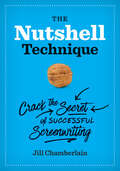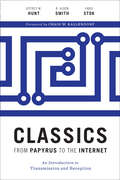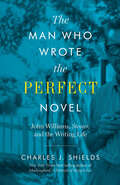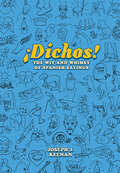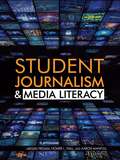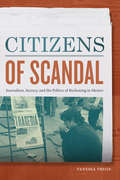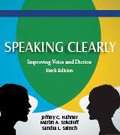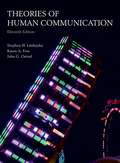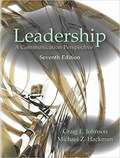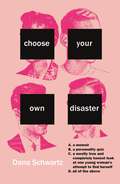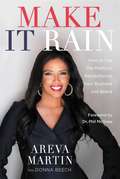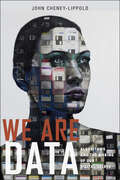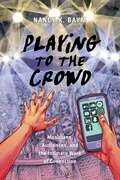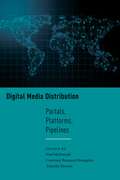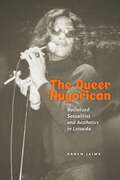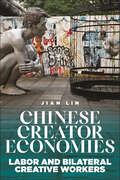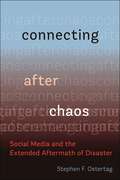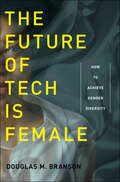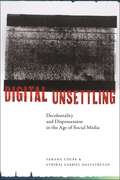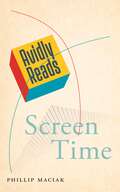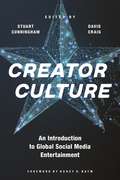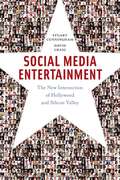- Table View
- List View
The Nutshell Technique: Crack the Secret of Successful Screenwriting
by Jill ChamberlainA veteran Hollywood script consultant unlocks the secrets of storytelling in this &“clever, fresh way of analyzing structure&” (Creative Screenwriting magazine). Veteran script consultant Jill Chamberlain knows that most first-time screenwriters don&’t understand how to tell a story. These writers may have snappy dialogue, interesting characters, and clever plot devices—but what they deliver isn&’t a story. It&’s a situation. In order to explain the difference, Chamberlain created the Nutshell Technique, a method whereby writers identify eight dynamic, interconnected elements that are required to successfully tell a story. In this book, Chamberlain uses easy-to-follow diagrams (&“nutshells&”) to explain how the Nutshell Technique can make or break a film script. She takes readers step-by-step through thirty classic and contemporary movies, showing how such dissimilar screenplays as Casablanca, Chinatown, Pulp Fiction, Little Miss Sunshine, Juno, and Argo all have the same system working behind the scenes. She then teaches readers how to apply these principles to their own screenwriting.
Classics from Papyrus to the Internet: An Introduction to Transmission and Reception (Ashley and Peter Larkin Series in Greek and Roman Culture)
by Jeffrey M. Hunt R. Alden SmithA &“valuable and useful&” history of the efforts and innovations that have kept ancient literary classics alive through the centuries (New England Classical Journal). Writing down the epic tales of the Trojan War and the wanderings of Odysseus in texts that became the Iliad and the Odyssey was a defining moment in the intellectual history of the West, a moment from which many current conventions and attitudes toward books can be traced. But how did texts originally written on papyrus in perhaps the eighth century BC survive across nearly three millennia, so that today people can read them electronically on a smartphone? Classics from Papyrus to the Internet provides a fresh, authoritative overview of the transmission and reception of classical texts from antiquity to the present. The authors begin with a discussion of ancient literacy, book production, papyrology, epigraphy, and scholarship, and then examine how classical texts were transmitted from the medieval period through the Renaissance and the Enlightenment to the modern era. They also address the question of reception, looking at how succeeding generations responded to classical texts, preserving some but not others. This sheds light on the origins of numerous scholarly disciplines that continue to shape our understanding of the past, as well as the determined effort required to keep the literary tradition alive. As a resource for students and scholars in fields such as classics, medieval studies, comparative literature, paleography, papyrology, and Egyptology, Classics from Papyrus to the Internet presents and discusses the major reference works and online professional tools for studying literary transmission.
The Man Who Wrote the Perfect Novel: John Williams, Stoner, and the Writing Life
by Charles J. ShieldsAn &“engrossing&” biography of a brilliant novelist underappreciated in his own time who became a twenty-first-century bestseller, from the New York Times–bestselling author (The New Yorker). When Stoner was published in 1965, the novel sold only a couple of thousand copies before disappearing with hardly a trace. Yet the quietly powerful tale of Midwestern college professor William Stoner, whose life becomes a parable of solitude and anguish, eventually found an admiring audience in America and especially in Europe. The New York Times called Stoner &“a perfect novel,&” and a host of writers and critics, including Colum McCann, Julian Barnes, Bret Easton Ellis, Ian McEwan, Emma Straub, Ruth Rendell, C.P. Snow, and Irving Howe, praised its artistry. The New Yorker deemed it &“a masterly portrait of a truly virtuous and dedicated man.&” This biography traces the life of Stoner&’s author, John Williams. Charles J. Shields follows the whole arc of Williams&’s life, which in many ways paralleled that of his titular character, from their shared working-class backgrounds to their undistinguished careers in academia. Shields vividly recounts Williams&’s development as an author, whose other works include the novels Butcher&’s Crossing and Augustus (for the latter, Williams shared the 1972 National Book Award). Shields also reveals the astonishing afterlife of Stoner, which garnered new fans with each American reissue, and then became a bestseller all over Europe after a Dutch publisher brought out a translation in 2013. Since then, Stoner has been published in twenty-one countries and sold over a million copies. &“Like Williams, Shields know how to tell a good story, one that will appeal especially to those interested in the ins and outs of the publishing industry and the ups and downs of a writer&’s life.&” —Los Angeles Review of Books
The Man Who Wrote the Perfect Novel: John Williams, Stoner, and the Writing Life
by Charles J. ShieldsAn &“engrossing&” biography of a brilliant novelist underappreciated in his own time who became a twenty-first-century bestseller, from the New York Times–bestselling author (The New Yorker). When Stoner was published in 1965, the novel sold only a couple of thousand copies before disappearing with hardly a trace. Yet the quietly powerful tale of Midwestern college professor William Stoner, whose life becomes a parable of solitude and anguish, eventually found an admiring audience in America and especially in Europe. The New York Times called Stoner &“a perfect novel,&” and a host of writers and critics, including Colum McCann, Julian Barnes, Bret Easton Ellis, Ian McEwan, Emma Straub, Ruth Rendell, C.P. Snow, and Irving Howe, praised its artistry. The New Yorker deemed it &“a masterly portrait of a truly virtuous and dedicated man.&” This biography traces the life of Stoner&’s author, John Williams. Charles J. Shields follows the whole arc of Williams&’s life, which in many ways paralleled that of his titular character, from their shared working-class backgrounds to their undistinguished careers in academia. Shields vividly recounts Williams&’s development as an author, whose other works include the novels Butcher&’s Crossing and Augustus (for the latter, Williams shared the 1972 National Book Award). Shields also reveals the astonishing afterlife of Stoner, which garnered new fans with each American reissue, and then became a bestseller all over Europe after a Dutch publisher brought out a translation in 2013. Since then, Stoner has been published in twenty-one countries and sold over a million copies. &“Like Williams, Shields know how to tell a good story, one that will appeal especially to those interested in the ins and outs of the publishing industry and the ups and downs of a writer&’s life.&” —Los Angeles Review of Books
Dichos! The Wit and Whimsy of Spanish Sayings
by Joseph J. KeenanA language guide &“exploring nearly 300 old and new expressions, proverbs and folk wisdom&” from the author of Breaking Out of Beginner&’s Spanish (The Eagle). One of the most challenging—and entertaining—aspects of learning another language is the idiom. Those quirky phrases, steeped in metaphor and colorful cultural references, enliven conversation and make your cross-cultural communication familiar, fun, and meaningful. ¡Dichos! (Sayings) brings us a vibrant compendium of both age-old and brand-new expressions from across Latin America, compiled by the language enthusiast whose Breaking Out of Beginner&’s Spanish transformed thousands of readers&’ interactions with the Spanish language. ¡Dichos! is divided into thematic sections covering topics ranging from games and relaxation to politics, macho men, and Mondays. Spanish speakers can also use the book to identify the spot-on/best slangy English equivalent for a Spanish-language idiom. Packed with gems like La barba me huele a tigre, y yo mismo me tengo miedo (My beard smells of tiger, and I&’m even afraid of myself) and Para todo mal, mezcal; para todo bien, también (For everything bad, mezcal; for everything good, likewise), this book is the ultimate tool for taking your language skills to the next level as you navigate nuance with humor and linguistic agility.
Dichos! The Wit and Whimsy of Spanish Sayings
by Joseph J. KeenanA language guide &“exploring nearly 300 old and new expressions, proverbs and folk wisdom&” from the author of Breaking Out of Beginner&’s Spanish (The Eagle). One of the most challenging—and entertaining—aspects of learning another language is the idiom. Those quirky phrases, steeped in metaphor and colorful cultural references, enliven conversation and make your cross-cultural communication familiar, fun, and meaningful. ¡Dichos! (Sayings) brings us a vibrant compendium of both age-old and brand-new expressions from across Latin America, compiled by the language enthusiast whose Breaking Out of Beginner&’s Spanish transformed thousands of readers&’ interactions with the Spanish language. ¡Dichos! is divided into thematic sections covering topics ranging from games and relaxation to politics, macho men, and Mondays. Spanish speakers can also use the book to identify the spot-on/best slangy English equivalent for a Spanish-language idiom. Packed with gems like La barba me huele a tigre, y yo mismo me tengo miedo (My beard smells of tiger, and I&’m even afraid of myself) and Para todo mal, mezcal; para todo bien, también (For everything bad, mezcal; for everything good, likewise), this book is the ultimate tool for taking your language skills to the next level as you navigate nuance with humor and linguistic agility.
Student Journalism and Media Literacy
by Homer L. Hall Aaron Manfull Megan FrommThis comprehensive resource covers everything student journalists need to know in a rapidly changing media landscape. Approachable and non-intimidating, this book features important concepts and examples from current school publications from around the country. Foremost, it teaches skills such as the fundamentals of good writing and the basics of newspaper layout and design. Also addressed, however, are topics that journalists are only now facing such as the responsibilities of citizen journalists, managing a news website, and digital security for reporters in the electronic age. This textbook is on the cutting edge in teaching students how to navigate this evolving field.
Citizens of Scandal: Journalism, Secrecy, and the Politics of Reckoning in Mexico
by Vanessa FreijeIn Citizens of Scandal, Vanessa Freije explores the causes and consequences of political scandals in Mexico from the 1960s through the 1980s. Tracing the process by which Mexico City reporters denounced official wrongdoing, she shows that by the 1980s political scandals were a common feature of the national media diet. News stories of state embezzlement, torture, police violence, and electoral fraud provided collective opportunities to voice dissent and offered an important, though unpredictable and inequitable, mechanism for political representation. The publicity of wrongdoing also disrupted top-down attempts by the ruling Partido Revolucionario Institucional to manage public discourse, exposing divisions within the party and forcing government officials to grapple with popular discontent. While critical reporters denounced corruption, they also withheld many secrets from public discussion, sometimes out of concern for their safety. Freije highlights the tensions—between free speech and censorship, representation and exclusion, and transparency and secrecy—that defined the Mexican public sphere in the late twentieth century.
Speaking Clearly: Improving Voice and Diction (Sixth Edition)
by Jeffrey C. Hahner Martin A. Sokoloff Sandra L. SalischIntercultural Communication: A Peacebuilding Perspective
by Martin S. Remland Tricia S. Jones Anita Foeman Dolores Rafter ArevaloWe live in an increasingly more globalized world, where living and working with people of various cultures is a nearly everyday occurrence. These interactions, combined with ever-growing opportunities for students to explore and study in foreign settings, make it important to master effective ways to engage and learn from these experiences. Intercultural Communication will engage readers interested in developing intercultural competence with an eye towards fostering diverse and vibrant communities that coexist peacefully. The authors begin by defining competent communication and describing how it contributes to peaceful communities before considering how cultural differences relate to the effects of cultural frames, emotions, and nonverbal and verbal communication. The second half of the book surveys how culture influences friendships, families, classrooms, workplaces, the media, and our visits to cultures different from our own. Recognizing the effects of these influences allows readers to take advantage of opportunities and overcome obstacles to more fully immerse themselves in a different way of life. Each chapter offers various boxed inserts with important and entertaining insights to supplement topics and provide opportunities for discussion.
Theories Of Human Communication
by Stephen W. Littlejohn Karen A. Foss John G. OetzelFor over forty years, Theories of Human Communication has energized classroom learning. John Oetzel joined the team of Stephen Littlejohn and Karen Foss, adding his expertise in intercultural, health, and organizational communication. The extensively updated edition is organized around two themes: elements of the basic communication model (communicator, message, medium, and "beyond" human communication) and communication contexts (relationship, group, organization, health, social media, culture, and society). A new chapter discusses frameworks by which theories can be organized, revealing how they contribute to and are impacted by larger issues about the nature of inquiry.
Leadership: A Communication Perspective
by Craig E. Johnson Michael Z. HackmanLeadership: A Communication Perspective has been at the forefront of university and college leadership courses for nearly three decades, providing a compelling, authoritative introduction to leadership as a communication-based activity. The new edition continues the tradition of excellence with an up-to-date treatment of theory and research combined with practical, real-world advice for improving communication competence and leadership effectiveness. The authors profile contemporary leaders and organizations like Alibaba's Jack Ma, Zappos' Tony Hsieh, Facebook's Sheryl Sandberg, Uber, The Container Store, Airbnb, Chipotle, the Waffle House, Nordstrom, and Google. Their presentation balances current scholarship and trends with historical perspectives to provide a fuller understanding of the study and practice of leadership. <p><p> Leadership and followership are examined in multiple contexts, including organizational leadership, public leadership, and leadership in groups and teams. Topics new to this edition include transcendent followership, the leadership skills approach, team coaching, escalation of commitment, invisible leadership, cultural intelligence, trigger events, and resilience.
Choose Your Own Disaster
by Dana SchwartzA hilarious, quirky, and unflinchingly honest memoir about one young woman's terrible and life-changing decisions while hoping (and sometimes failing) to find herself, in the style of Never Have I Ever and Adulting. Join Dana Schwartz on a journey revisiting all of the terrible decisions she made in her early twenties through the internet's favorite method of self-knowledge: the quiz. Part-memoir, part-VERY long personality test, CHOOSE YOUR OWN DISASTER is a manifesto about the millennial experience and modern feminism and how the easy advice of "you can be anything you want!" is actually pretty fucking difficult when there are so many possible versions of yourself it seems like you could be. Dana has no idea who she is, but at least she knows she's a Carrie, a Ravenclaw, a Raphael, a Belle, a former emo kid, a Twitter addict, and a millennial just trying her best.
Make It Rain!: How To Use The Media To Revolutionize Your Business & Brand
by Areva Martin Donna Beech Phil McGrawWhat if you could get in front of millions of prospects with the avid endorsement of famous influencers--without spending a dime?It's happening right in front of you every day. Guest experts on TV, radio, podcasts, blogs, and live streaming are getting local and national exposure for their business and brand that they could never have afforded to reach with ads.For a decade, Areva Martin has used the media to build a huge platform that expanded the influence and power of her brand exponentially. Media appearances on Dr. Phil, Anderson Cooper 360, The Doctors, CNN, MSNBC, FOX, and more have virtually eliminated the need of a marketing budget for her thriving law firm and non-profit organization, while securing her place as one of America's most sought after thought leaders.In Make It Rain! Areva breaks the silence to reveal what insiders know about the power of media appearances to revolutionize a business and brand and get your core message out to the people who need it most. You'll learn how to: Match your brand to the right audience and media venues Craft pitches producers can't resist Jump on breaking news shows Pivot and speak in soundbites like the pros Amplify every interview with social media Turn appearances into platform and become a rainmakerNever before have there been more ways to build a presence that matters. Whether you are the executive of a corporation, the author of an upcoming book, the owner of a rapidly growing small business, or the public face of a local nonprofit or association, if you have a business to build or people you want to help, nothing beats using the media to create the visibility, influence, and power you need. Are you ready to Make It Rain!?
We Are Data: Algorithms and the Making of Our Digital Selves
by John Cheney-LippoldWhat identity means in an algorithmic age: how it works, how our lives are controlled by it, and how we can resist itAlgorithms are everywhere, organizing the near limitless data that exists in our world. Derived from our every search, like, click, and purchase, algorithms determine the news we get, the ads we see, the information accessible to us and even who our friends are. These complex configurations not only form knowledge and social relationships in the digital and physical world, but also determine who we are and who we can be, both on and offline. Algorithms create and recreate us, using our data to assign and reassign our gender, race, sexuality, and citizenship status. They can recognize us as celebrities or mark us as terrorists. In this era of ubiquitous surveillance, contemporary data collection entails more than gathering information about us. Entities like Google, Facebook, and the NSA also decide what that information means, constructing our worlds and the identities we inhabit in the process. We have little control over who we algorithmically are. Our identities are made useful not for us—but for someone else. Through a series of entertaining and engaging examples, John Cheney-Lippold draws on the social constructions of identity to advance a new understanding of our algorithmic identities. We Are Data will educate and inspire readers who want to wrest back some freedom in our increasingly surveilled and algorithmically-constructed world.
Playing to the Crowd: Musicians, Audiences, and the Intimate Work of Connection (Postmillennial Pop #14)
by Nancy K. BaymExplains what happened to music—for both artists and fans—when music went online. Playing to the Crowd explores and explains how the rise of digital communication platforms has transformed artist-fan relationships into something closer to friendship or family. Through in-depth interviews with musicians such as Billy Bragg and Richie Hawtin, as well as members of the Cure, UB40, and Throwing Muses, Baym reveals how new media has facilitated these connections through the active, and often required, participation of the artists and their devoted, digital fan base.Before the rise of social sharing and user-generated content, fans were mostly seen as an undifferentiated and unidentifiable mass, often mediated through record labels and the press. However, in today’s networked era, musicians and fans have built more active relationships through social media, fan sites, and artist sites, giving fans a new sense of intimacy and offering artists unparalleled information about their audiences. However, this comes at a price. For audiences, meeting their heroes can kill the mystique. And for artists, maintaining active relationships with so many people can be both personally and financially draining, as well as extremely labor intensive.Drawing on her own rich history as an active and deeply connected music fan, Baym offers an entirely new approach to media culture, arguing that the work musicians put in to create and maintain these intimate relationships reflect the demands of the gig economy, one which requires resources and strategies that we must all come to recognize and appreciate.
Digital Media Distribution: Portals, Platforms, Pipelines (Critical Cultural Communication)
by Paul McDonald Courtney Brannon Donoghue Timothy HavensA deep dive into the new era of digital content production and distributionIn the twenty-first century, the platforms that both create and host content have become nearly as important as media itself. Companies such as Netflix, Spotify, and YouTube have attained a massive hold on the public imagination and have become an almost ineluctable part of people’s everyday lives. While the workings of media distribution had until very recently remained inconsequential to the average consumer, the recent popularization of various online platforms has made the question of distribution immediate to everyone. Digital Media Distribution: Portals, Platforms, Pipelines provides a timely examination of the multifaceted distribution landscape in a moment of transformation and conceptualizes media distribution as a complex site of power, privilege, and gatekeeping. These tensions have local, national, and global consequences on the autonomy of creative workers, as well as on how we gain access to, engage with, and understand cultural products. Drawing on original research into distribution practices in industries as diverse as television, film, videogames, literature, and adult entertainment, each chapter explores how digitization has changed media distribution and its broader economic, industrial, social, and cultural implications.Bringing together experts from around the world and across the media industries, Digital Media Distribution: Portals, Platforms, Pipelines presents a vast array of critical approaches and illustrative case studies for understanding the factors that have an impact on the way media travels and moves throughout our digital lives.
The Queer Nuyorican: Racialized Sexualities and Aesthetics in Loisaida (Performance and American Cultures #4)
by Karen JaimeA queer genealogy of the famous performance space and the nuyorican aesthetic One could easily overlook the Nuyorican Poets Cafe, a small, unassuming performance venue on New York City’s Lower East Side. Yet the space once hosted the likes of Victor Hernández Cruz, Allen Ginsberg, and Amiri Baraka and is widely credited as the homespace for the emergent nuyorican literary and aesthetic movement of the 1990s. Founded by a group of counterculturalist Puerto Rican immigrants and artists in the 1970s, the space slowly transformed the Puerto Rican ethnic and cultural associations of the epithet “Nuyorican,” as the Cafe developed into a central hub for an artistic movement encompassing queer, trans, and diasporic performance.The Queer Nuyorican is the first queer genealogy and critical study of the historical, political, and cultural conditions under which the term “Nuyorican” shifted from a raced/ethnic identity marker to “nuyorican,” an aesthetic practice. The nuyorican aesthetic recognizes and includes queer poets and performers of color whose writing and performance build upon the politics inherent in the Cafe’s founding. Initially situated within the Cafe’s physical space and countercultural discursive history, the nuyorican aesthetic extends beyond these gendered and ethnic boundaries, broadening the ethnic marker Nuyorican to include queer, trans, and diasporic performance modalities.Hip-hop studies, alongside critical race, queer, literary, and performance theories, are used to document the interventions made by queer and trans artists of color—Miguel Piñero, Regie Cabico, Glam Slam participants, and Ellison Glenn/Black Cracker—whose works demonstrate how the Nuyorican Poets Cafe has operated as a queer space since its founding. In focusing on artists who began their careers as spoken word artists and slam poets at the Cafe, The Queer Nuyorican examines queer modes of circulation that are tethered to the increasing visibility, commodification, and normalization of spoken word, slam poetry, and hip-hop theater in the United States and abroad.
Chinese Creator Economies: Labor and Bilateral Creative Workers (Critical Cultural Communication)
by Jian LinThe paradoxical relationship between Chinese creative workers and the stateChinese Creator Economies dives into the paradoxical lives lived by creative professionals in emerging economies across China. Jian Lin contextualizes the socioeconomic conditions in which cultural production takes place and pushes back against the dominant understanding of Chinese media as a centralized, state-controlled apparatus by looking at how individual creative workers grapple with governance and precarity in the Chinese cultural industries and develop their bilateral subjectivities within the politico-economic system of Chinese media. Drawing on intensive empirical research conducted on creative labor practices across television, journalism, design, and social media, Chinese Creative Economies looks at both Chinese and foreign-born content creators, exploring the tensions between Beijing’s limits on individual creativity, and its aspirations to become a global hub for cultural production. Lin maintains that it is the production of bilateral creatives that generates and maintains hope for the future of those who live and work within the cultural economies of China.
Connecting After Chaos: Social Media and the Extended Aftermath of Disaster
by Stephen F. OstertagA riveting portrait of how one community used the power of culture to restore their lives and socialconnections in the years after a devastating natural disasterNatural disasters and other such catastrophes typically attract large-scale media attention and public concern in their immediate aftermath. However, rebuilding efforts can take years or even decades, and communities are often left to repair physical and psychological damage on their own once public sympathy fades away. Connecting After Chaos tells the story of how people restored their lives and society in the months and years after disaster, focusing on how New Orleanians used social media to cope with trauma following Hurricane Katrina.Stephen F. Ostertag draws on almost a decade of research to create a vivid portrait of life in “settling times,” a term he defines as a distinct social condition of prolonged insecurity and uncertainty after disasters. He portrays this precarious state through the story of how a group of strangers began blogging in the wake of Katrina, and how they used those blogs to put their lives and their city back together. In the face of institutional failure, weak authority figures, and an abundance of chaos, the people of New Orleans used social media to gain information, foster camaraderie, build support networks, advocate for and against proposed policies, and cope with trauma. In the efforts of these bloggers, Ostertag finds evidence of the capacity of this and other forms of cultural work to motivate, guide, and energize collective action aimed at weathering the constant instability of extended recovery periods. Connecting After Chaos is both a compelling story of a community in crisis and a broader argument for the power of social media and cultural cooperation to create order when chaos abounds.
The Future of Tech Is Female: How to Achieve Gender Diversity
by Douglas M BransonAn accessible and timely guide to increasing female presence and leadership in tech companies Tech giants like Apple and Google are among the fastest growing companies in the world, leading innovations in design and development. The industry continues to see rapid growth, employing millions of people: in the US it is at the epicenter of the American economy. So why is it that only 5% of senior executives in the tech industry are female? Underrepresentation of women on boards of directors, in the C-suite, and as senior managers remains pervasive in this industry. As tech companies are plagued with high-profile claims of harassment and discrimination, and salary discrepancies for comparable work, one asks what prevents women from reaching management roles, and, more importantly, what can be done to fix it? The Future of Tech is Female considers the paradoxes involved in women’s ascent to leadership roles, suggesting industry-wide solutions to combat gender inequality. Drawing upon 15 years of experience in the field, Douglas M. Branson traces the history of women in the information technology industry in order to identify solutions for the issues facing women today. Branson explores a variety of solutions such as mandatory quota laws for female employment, pledge programs, and limitations on the H1-B VISA program, and grapples with the challenges facing women in IT from a range of perspectives. Branson unpacks the plethora of reasons women should hold leadership roles, both in and out of this industry, concluding with a call to reform attitudes toward women in one particular IT branch, the video and computer gaming field, a gateway to many STEM futures. An invaluable resource for anyone invested in gender equality in corporate governance, The Future of Tech is Female lays out the first steps toward a more diverse future for women in tech leadership
Digital Unsettling: Decoloniality and Dispossession in the Age of Social Media (Critical Cultural Communication)
by Sahana Udupa Ethiraj Gabriel DattatreyanHow digital networks are positioned within the enduring structures of colonialityThe revolutionary aspirations that fueled decolonization circulated on paper—as pamphlets, leaflets, handbills, and brochures. Now—as evidenced by movements from the Arab Spring to Black Lives Matter—revolutions, protests, and political dissidence are profoundly shaped by information circulating through digital networks. Digital Unsettling is a critical exploration of digitalization that puts contemporary “decolonizing” movements into conversation with theorizations of digital communication. Sahana Udupa and Ethiraj Gabriel Dattatreyan interrogate the forms, forces, and processes that have reinforced neocolonial relations within contemporary digital environments, at a time when digital networks—and the agendas and actions they proffer—have unsettled entrenched hierarchies in unforeseen ways. Digital Unsettling examines events—the toppling of statues in the UK, the proliferation of #BLM activism globally, the rise of Hindu nationalists in North America, the trolling of academics, among others—and how they circulated online and across national boundaries. In doing so, Udupa and Dattatreyan demonstrate how the internet has become the key site for an invigorated anticolonial internationalism, but has simultaneously augmented conditions of racial hierarchy within nations, in the international order, and in the liminal spaces that shape human migration and the lives of those that are on the move. Digital Unsettling establishes a critical framework for placing digitalization within the longue durée of coloniality, while also revealing the complex ways in which the internet is entwined with persistent global calls for decolonization.
Avidly Reads Screen Time
by Phillip MaciakWhat happens when screen time is all the time?In the early 1990s, the phrase “screen time” emerged to scare parents about the dangers of too much TV for kids. Screen time was something to fret over, police, and judge in a low-grade moral panic. Now, “screen time” has become a metric not only for good parenting, but for our adult lives as well. There’s even an app for it! In the streaming era—and with streaming made nearly ubiquitous during COVID-19—almost every aspect of our day is mediated by these bright surfaces. Whether it was ever the real villain in the first place, or merely a convenient proxy for unaddressed familial, social, and institutional failures, screen time is now all the time.Avidly Reads Screen Time is a funny, insightful work of cultural criticism and history about how we define screens, and how they now define us. From Mad Men to iCarly, Vine to FaceTime, binge-watching to doom-scrolling, Phillip Maciak leads us on a sometimes heartwarming, sometimes harrowing tour of the media that brings us together and tears us apart.
Creator Culture: An Introduction to Global Social Media Entertainment
by Stuart Cunningham David CraigExplores new perspectives on social media entertainmentThere is a new class of cultural producers—YouTube vloggers, Twitch gameplayers, Instagram influencers, TikTokers, Chinese wanghong, and others—who are part of a rapidly emerging and highly disruptive industry of monetized “user-generated” content. As this new wave of native social media entrepreneurs emerge, so do new formations of culture and the ways they are studied.In this volume, contributors draw on scholarship in media and communication studies, science and technology studies, and social media, Internet, and platform studies, in order to define this new field of study and the emergence of creator culture. Creator Culture introduces readers to new paradigms of social media entertainment from critical perspectives, demonstrating both relations to and differentiations from the well-established media forms and institutions traditionally within the scope of media studies.This volume does not seek to impose a uniform perspective; rather, the goal is to stimulate in-depth, globally-focused engagement with this burgeoning industry and establish a dynamic research agenda for scholars, teachers, and students, as well as creators and professionals across the media, communication, creative, and social media industries.Contributors include: Jean Burgess, Zoë Glatt, Sarah Banet-Weiser, Brent Luvaas, Carlos A. Scolari, Damián Fraticelli, José M. Tomasena, Junyi Lv, Hector Postigo, Brooke Erin Duffy, Megan Sawey, Jarrod Walzcer, Sangeet Kumar, Sriram Mohan, Aswin Punathambekar, Mohamed El Marzouki, Elaine Jing Zhao, Arturo Arriagada, Jeremy Shtern, Stephanie Hill
Social Media Entertainment: The New Intersection of Hollywood and Silicon Valley (Postmillennial Pop #7)
by David Craig Stuart CunninghamHow the transformation of social media platforms and user-experience have redefined the entertainment industry In a little over a decade, competing social media platforms, including YouTube, Facebook, Twitter, Instagram, and Snapchat, have given rise to a new creative industry: social media entertainment. Operating at the intersection of the entertainment and interactivity, communication and content industries, social media entertainment creators have harnessed these platforms to generate new kinds of content separate from the century-long model of intellectual property control in the traditional entertainment industry. Social media entertainment has expanded rapidly and the traditional entertainment industry has been forced to cede significant power and influence to content creators, their fans, and subscribers. Digital platforms have created a natural market for embedded advertising, changing the worlds of marketing and communication in their wake. Combined, these factors have produced new, radically shifting demands on the entertainment industry, posing new challenges for screen regimes, media scholars, industry professionals, content creators, and audiences alike. Stuart Cunningham and David Craig chronicle the rise of social media entertainment and its impact on media consumption and production. A massive, industry-defining study with insight from over 100 industry insiders, Social Media Entertainment explores the latest transformations in the entertainment industry in this time of digital disruption.
